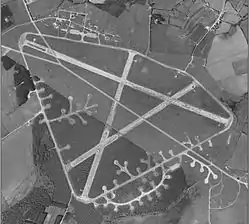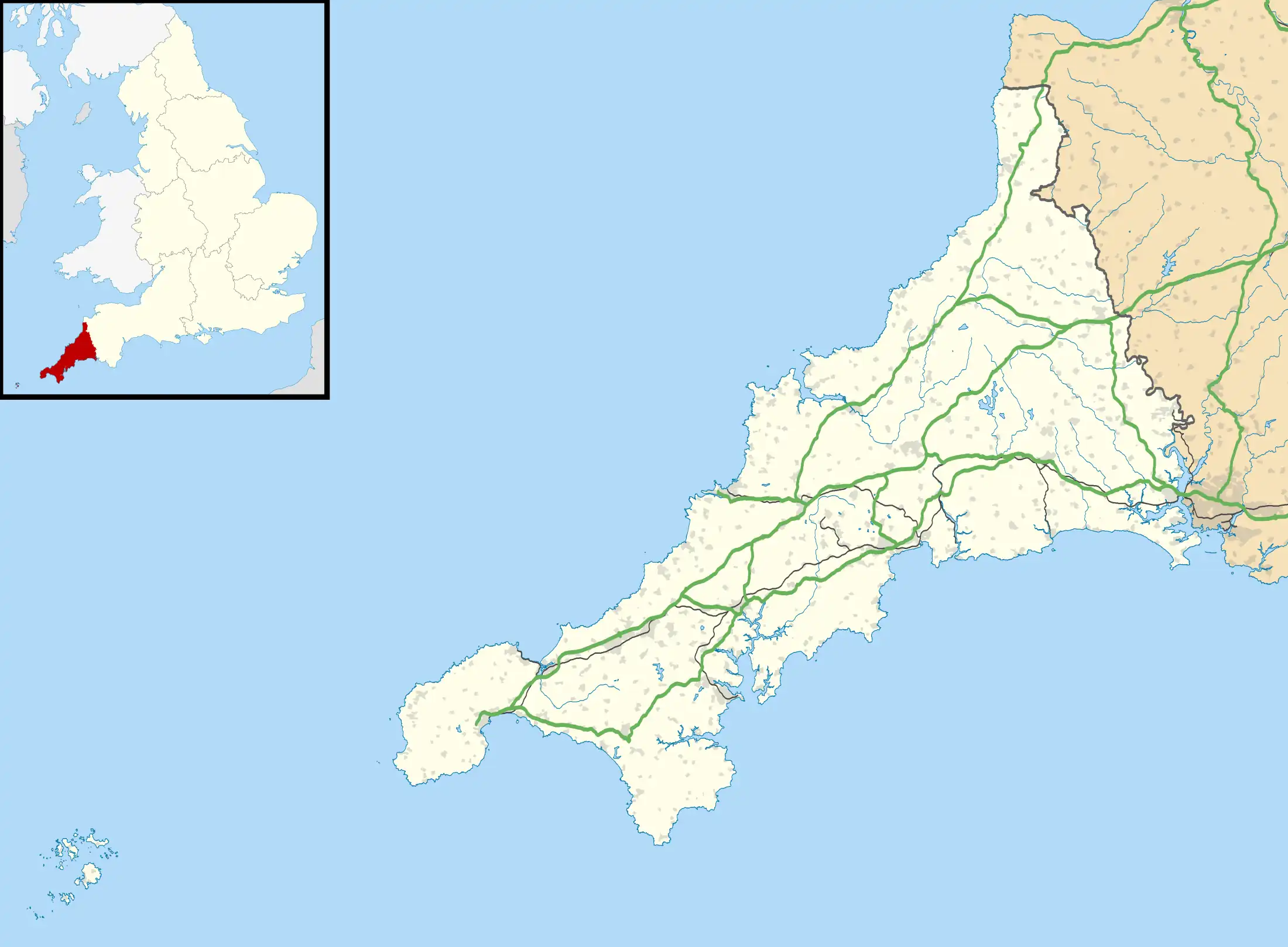| RAF Davidstow Moor | |||||||||||
|---|---|---|---|---|---|---|---|---|---|---|---|
| Davidstow, Cornwall in England | |||||||||||
 RAF Davidstow Airfield – 2 June 1951 | |||||||||||
 RAF Davidstow Moor Shown within Cornwall | |||||||||||
| Coordinates | 50°38′07″N 004°37′04″W / 50.63528°N 4.61778°W | ||||||||||
| Type | Royal Air Force station | ||||||||||
| Site information | |||||||||||
| Owner | Air Ministry | ||||||||||
| Operator | Royal Air Force | ||||||||||
| Site history | |||||||||||
| Built | 1942 | ||||||||||
| In use | 1942-1945 | ||||||||||
| Airfield information | |||||||||||
| Elevation | 294 metres (965 ft) AMSL | ||||||||||
| |||||||||||
Royal Air Force Davidstow, or more simply RAF Davidstow Moor, is a former Royal Air Force station located 2.9 miles (4.7 km) north east of Camelford, Cornwall and 11.5 miles (18.5 km) west of Launceston, Cornwall, England.
It was used from late 1942 until 1945, and despite a few periods of intense activity it was one of Coastal Command's lesser used airfields.
History
The land was acquired in 1941, and a three-runway airfield with extensive dispersal areas was constructed in the first half of 1942. Despite the moorland conditions, construction was reasonably straightforward, although it did involve the removal of various field boundaries, the closure of minor roads and some drainage work.
RAF Davidstow Moor closed in December 1945 at the end of World War II and many of the buildings, including the hangars were soon removed. It became a motor racing circuit, known as Davidstow Circuit and in the early 1950s, three Formula One races were held there (the Cornwall MRC Formula 1 Races) including the first success for the Lotus marque.
Posted units
| Squadron | Dates stationed | Planes used | Duties |
|---|---|---|---|
| 53 Sqn | 1 January 1943 – 18 February 1943 | Lockheed Hudson | |
| 144 Sqn | 10 May 1944 – 1 July 1944 | Bristol Beaufighter | Covered the west flank of the Normandy landings. Helped to destroy the German naval forces in Western France |
| 192 Sqn | [1] | ||
| 206 Sqn | 18 March 1944 – 12 April 1944 | Consolidated Liberator, Boeing Fortress | |
| 269 Sqn | 8 January 1944 – 8 March 1944 | Lockheed Hudson, Supermarine Walrus | Air-sea rescue duties |
| 280 Sqn | [1] | ||
| 281 Sqn det | December 1943 – February 1945 | Vickers Warwick | Air sea rescue duties |
| 282 Sqn | 1 February 1944 – 19 September 1944 | Vickers Warwick | Air sea rescue duties |
| 304 Sqn | 7 June 1943 – 13 December 1943 | Vickers Wellington | Anti-submarine patrols over the Bay of Biscay |
| 404 Sqn RCAF | 8 May 1944 – September 1944 | Bristol Beaufighter | |
| 524 Sqn | 7 April 1944 – 1 July 1944 | Vickers Wellington | Patrols against E-Boats off the French coast |
| 547 Sqn | 31 May 1943 – 25 October 1943 | Vickers Wellington | Anti-submarine patrols over the Bay of Biscay |
| 612 Sqn | 12 April 1943 – 25 May 1943 | Vickers Wellington | Anti-submarine patrols over the Channel and the Bay of Biscay |
| 845 Naval Air Squadron | [1] | ||
| 1603 (AAC) Flt | 16 December 1942 – 27 January 1943 | Hawker Henley | Target towing |

A number of RAF Regiment units were also posted here at some point:[1]
Wings;
Squadrons;
Current use
The disused former watch office/air traffic control tower is clearly visible on the airfield.
The airfield is still partly used by microlights and motor gliders[2] with three runways in use. The runway lengths and directions are: 02–20, 395m, 06–24, 489m, 12–30, 1,450m. PPR (prior permission required) is essential for this site. It is currently run by Davidstow Flying Club.
Davidstow Airfield and Cornwall at War Museum
The Davidstow Airfield and Cornwall at War Museum[3] has been set up to commemorate the work and people of RAF Davidstow Moor.
It is located next to a creamery where Davidstow and Cathedral City cheeses are produced. Many exhibits cover life in World War II in Cornwall, including other airfields along the North Cornwall coast, the Royal Navy, Army and civilian services, and life on the home front. Other exhibits include artifacts from the Royal Observer Corps and the Light Infantry, vehicles and weapons. A new hangar was completed in 2016 and now houses a growing collection of larger exhibits including a Fairey Gannet and Hawker Hunter F.6 aircraft, the cockpit section of a DH Vampire T.11 as well as a number of rare airfield and military vehicles.
Davidstow Moor RAF Memorial Museum
The adjacent yet separate Davidstow Moor RAF Memorial Museum is located in the former sergeants' shower block and focuses on the airfield's history during World War II using archive photographs and memorabilia.[4]
Unauthorised festival
An unauthorised open-air music and dance event was held on the site in June 2022.[5]
References
Citations
- 1 2 3 4 "Davidstow Moor". Airfields of Britain Conservation Trust. Retrieved 24 May 2020.
- ↑ "Data Card with up to date information".
- ↑ http://www.cornwallatwarmuseum.co.uk Davidstow Airfield and Cornwall at War Museum
- ↑ "Official site". Davidstow Moor RAF Memorial Museum. Retrieved 7 March 2015.
- ↑ Raines, Jeff (4 June 2022). "Cornwall illegal rave: Police officers assaulted at Davidstow Moor gathering". Cornwall Live. Local World.
Bibliography
- Ordnance Survey: Landranger map sheet 200 Newquay & Bodmin ISBN 978-0-319-22938-5
- Delve, Ken The Military Airfields of Britain, South-Western England: Channel Islands, Cornwall, Devon, Dorset, Gloucestershire, Somerset, Wiltshire. ISBN 1-86126-810-6
- A Guide to Airfields of South Western England. Baron Jay Publishers
- Keast, David C. Memories and Records of RAF Davidstow Moor, Cornwall [Camelford: the Author?]
- Knight, Rod & Anne (2016, 2nd edition) RAF Davidstow Moor 1942 to 1945. A Wartime History [CAWM Publishing, Cornwall at War Museum, Davidstow] ISBN 978-0-9576112-0-7
External links
- www.rafdavidstowmoor.com RAF Davidstow Moor
- Cached Version of the above websites homepage
- Davistow Airfield and Cornwall at War Museum
- Davidstow Moor RAF Memorial Museum
- www.controltowers.co.uk RAF Davidstow Moor
- www.wartimememories.co.uk RAF Davidstow Moor
- Peter Ascott's recollections of the aerodrome